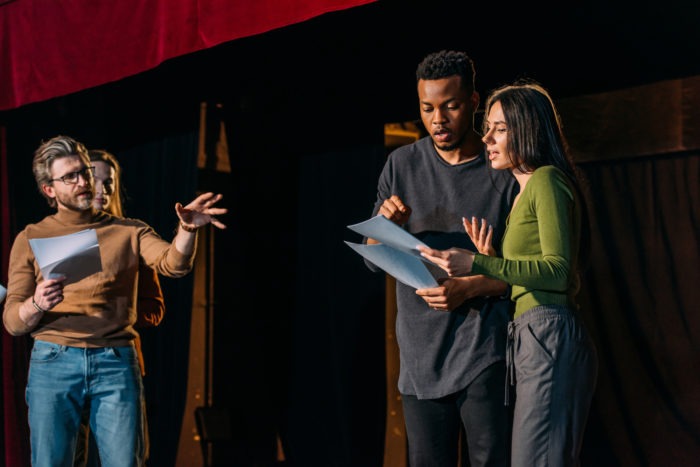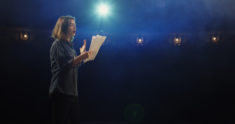
Planning and participating in UX workshops, particularly the UX research phase of my projects, sparked a memory from my old drama classes. Actors need to empathise with a character and put themselves in their character’s shoes.
They are trained to completely lose themselves in the character and enter the character’s world. The actor’s quest to get into character mirrors UX researchers’ quest to understand the user. What would I do in that situation? How would I feel? Have I ever been in a similar predicament? The ability to feel and imagine is essential to portray authentic performances; highlighting the character’s raw emotions.
I will explore how recreating UX workshops that centre on the Stanislavski acting method is crucial for participants to get deeper user insights.
There are various drama techniques that require empathising and fostering one’s imagination to not only understand a character but be the character. The acting techniques include the Stanislavski, Meisner and Chekhov methods, method acting, and practical aesthetics.
By exploring these drama techniques and shifting the focus from the character to the user, I will demonstrate creative and effective ways to get greater user insight, by not only understanding the user but by being the user!
The Stanislavski method
The Stanislavski method is an acting technique that embraces the ‘art of experiencing.’
It encourages actors to internalise their character’s inner life, including motivations and emotions. Invented in the nineteenth century, it is practiced by many actors and predominantly performed in theatre.
Let’s take a look at the core principles of the Stanislavski method:
-
‘The Magic If’
One of the well-known principles of the Stanislavski method is “the Magic If.” An approach where the actor imagines themselves in the circumstances of the character and environment. This heightens the actor's imagination and intimately connects them to the character, awakening them.
-
Given circumstances
This principle focuses on all the specific details of the character’s background. That’s knowing all the specific details of the character’s background; personality, environment; favourite foods, most gut-wrenching heartbreak, you name it. Every last detail. Are they early birds? What frustrates them the most? What are they concerned about?
-
Super-objective
This key principle highlights the character’s primary motivation. It’s the backbone of the character, knowing the thing that they want more than anything in this world. What makes this effective is if the actor’s objectives and actions on stage connect with the character’s super-objective.
-
Sub-objective
This stage is to understand what else the character wants. Their secondary motivations if you like. The super and sub-objectives together help to give a more complete understanding of their needs.
-
Emotional memory
Actors are encouraged to develop their ability to observe emotional reactions in their personal lives. Their emotional memories felt off-stage are used to spark an emotional connection and deep sense of empathy with the character, acted on stage. By relating to their character’s experiences it can trigger strong emotions and a spectacular authentic performance.
How can we incorporate the Stanislavski approach in a UX workshop to get a deeper understanding of the user and their experience?
Provide participants with a task prior to the workshop. Let’s assume the workshop participants are a variety of actors; UX designers, users, business stakeholders, project managers and developers. Each with their own objectives for participating; the task is to not only understand the users but be the users!

Given circumstances
Shared with participants prior to the workshopUX workshop's goal. For example, ‘To create a new feature that eases the user’s experience as they rush to work’.’ Organisers share general info about the users and present participants with a task. Organisers will cluster users into groups, for example, elderly users struggling with the complexity of the device or users who only use the app on the way to work. Participants are then advised to choose which type of user they want to act.
Note: Participants also have the option to choose their own user based on their detailed research.
Task 1:
Do detailed research into the users; including the problems, goals (long & short term), concerns and research of the industry, and latest trends. Interview users and get as much information as possible. For example, Toni loves to go to the gym super early at 6 am, he uses a motivational app to inspire him in the mornings. What does he usually struggle most with in the app”
Task 2:
Create a user persona and user journey map to understand your user and their daily life.
Super and sub-objective
Prior to the workshop, the participants send the deliverables to the organisers. The organiser puts the participants into pairs, according to their user personas.
At the workshop, participants are matched with their counterparts, to collectively get into the user's mind. They discuss their user as well as their primary and secondary motivations in detail.
Task 3:
Once insights are discussed they produce detailed user journey maps and start writing a script together.
Emotional memory
Emotional memory in the Stanislavski technique is a phenomenal feeling that can trigger emotion, empathy for the users and creativity.
Task 4:
Participants can spend 10 mins to reflecting and even doing a short meditation and relate to an experience similar to the user.
Note: you can always find one, and if not use your imagination 🙂
The emotional connection and empathy can allow participants to further understand the user, drawing parallels with their own experience. This insight can inspire them to see multiple angles of the user’s experience and their problems.
The ‘Magic If’
What would I do if I was in the user’s shoes? What are the users going through in their lives? How do they feel when they open the app or start an experience? This ‘magic if’ approach is the perfect mindset to inspire participants to write a script and detailed notes on everything about the user.
Task 5:
Who? What? Where? Why? Answer these questions to help you write the script with your fellow participant. Once the script is written, the participants have the two options to perform their final task.
Be the user
The two effective options include a monologue and an improvised dialogue with two participants. Both methods can work as it portrays the much needed raw emotions of the user on stage.
Task 6:
Rise and shine!
Once performed on stage, participants can ideate on intuitive and innovative solutions. Who can do so better than an actor in character?
Research + imagination = Creative & intuitive solutions
You can see Zara's UX portfolio here.
Further reading:
Acting in Switzerland by Aicha Saliou-Diallo



